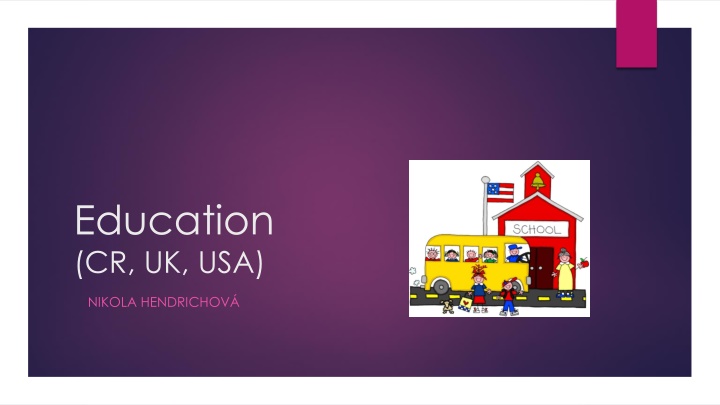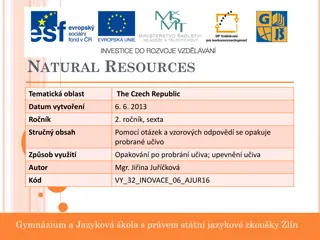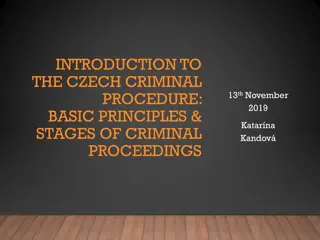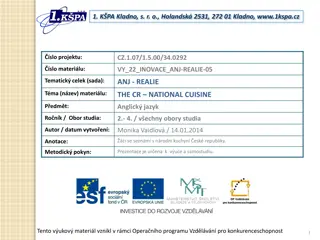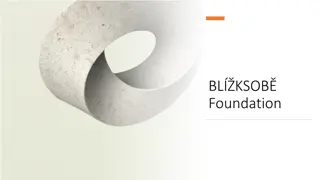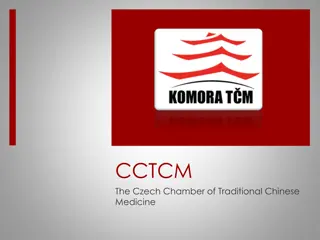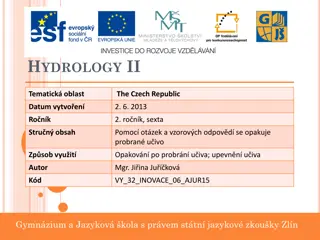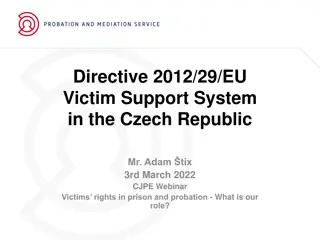Overview of the Czech Education System: Levels, Structure & Details
The Czech education system comprises pre-school, primary, secondary, and higher secondary levels. Pre-school education includes nursery and kindergarten, primary education focuses on foundational skills and knowledge, secondary education covers a broader range of subjects, and higher secondary offers various specialized school types. The system is structured to progressively prepare students for further studies or careers. Education is compulsory at the primary and lower secondary levels, with specific subjects and age ranges for each level. Various types of schools offer different educational paths, culminating in exams such as the maturita exam.
Download Presentation

Please find below an Image/Link to download the presentation.
The content on the website is provided AS IS for your information and personal use only. It may not be sold, licensed, or shared on other websites without obtaining consent from the author.If you encounter any issues during the download, it is possible that the publisher has removed the file from their server.
You are allowed to download the files provided on this website for personal or commercial use, subject to the condition that they are used lawfully. All files are the property of their respective owners.
The content on the website is provided AS IS for your information and personal use only. It may not be sold, licensed, or shared on other websites without obtaining consent from the author.
E N D
Presentation Transcript
Education (CR, UK, USA) NIKOLA HENDRICHOV
What do you know about the Czech education system? Levels Age Lenght Types of schools Educational content (subjects) Exams .
Vocabulary Nursery, kindergarten, playgroup National curriculum Grade, year Arts Pupils Tuition fees Report card Aptitude test Apprentice school Entrance exams Crafts Vocational
The Czech Education System Levels Pre-school Primary Secondary Terciary
Pre-school education Nursery school, kindergarten 3 6 yo, obligatory from 5 Learning through games, songs and chants, everyday routines, Preparation for primary education
Primary education Grades 1 5 Age 6 11 Learning to count, write, read, getting to know the world, forming behaviour, morals and routines One class teacher for most subjects Obligatory
Secondary education Lower secondary 1. Grades 6 9 Age 11 15 Basic subjects Czech, maths, foreing language/s (English, German); specialized subjects history, science (biology, chemistry, physics), Different teachers for different subjects Obligatory Mostly the same for everyone, with slight differences (grammar schools, schools with some specialization sport, languages, )
2. Higher secondary (US high school) Grade 1 4 Age 15 19 Various types of schools 3-year apprentice schools (specialized, vocational, e. g. crafts; apprentice exam) 4-year specialized schools (academic or vocational - business, health care, IT, , preparation for a career in a specific area; maturita exam) Grammar schools (4-year or 8-year, academic education, preparation for university; maturita exam) - - -
Other facts The primary and lower secondary levels are obligatory by law School starts at 8 am Pupils have approximately 6 lessons per day One lesson lasts 45 minutes There are 10-minute breaks, some are longer Pupils don t wear uniforms Pupils get marks (1 5) Schools can be state or private Schools follow a prescribed national curriculum
Terciary education Universities Age 19 26 (supported by the state) Bachelor degree programmes 3 years (BA Bc.) Master degree programmes 2 years (MA Mgr., Ing.) 4 6 years primary teachers, doctors, lawyers Various fields of study (arts, pedagogy, science, ingeneering, ) Charles University in Prague, Masaryk University in Brno, Technical University of Liberec,
The British Education system Age of 3 nursery schools, playgroups Age of 5 primary school (zero year) Age of 6 primary school (1st year) Age of 11 secondary school Age of 16 GCSE (General Certificate of Secondary Education) exam in 8 or 9 subjects Age of 16 can leave school or continue studying a sixth form college (4 subjects, A-level exams) academic or practical education Age of 18 universities (BA, MA; tuition fee)
Basic facts Pupils wear uniforms Pupils get letters for marks (A E, U fail) School starts at nine Schools are public or private Schools follow a prescribed national curriculum Boarding schools
The American Education System Age 3 or 4 paid pre-school Age of 5 - 6 kindergarten Age of 6 elementary/grade school 5 grades; curriculum determined by a district, basic subjects English, Maths, science Age of 11 Junior High/middle school Age of 15 High School (4 grades with special names) academic and vocational 3rd grade of high school SAT (Scholastic Aptitute Test) measures possible success with passing entrance exams to university Completion of high school celebrated with a graduation ceremony Universities and colleges Yale, Harvard (Ivy League schools)
Basic facts Morning routine of Pledge of Allegiance Public (mostly) or private schools Grading system A D, F for fail Testing in quizzes, essays, other projects
What are the differences between Czech, British and American schooling?
Sources http://www.bridge-online.cz/wp- content/uploads/2016/09/27_education_uk_usa_cr.pdf Images.google.com
